Contents
Not a single suburban area is complete without garlic ridges. After all, it is a seasoning, a medicine, and protection against pests.
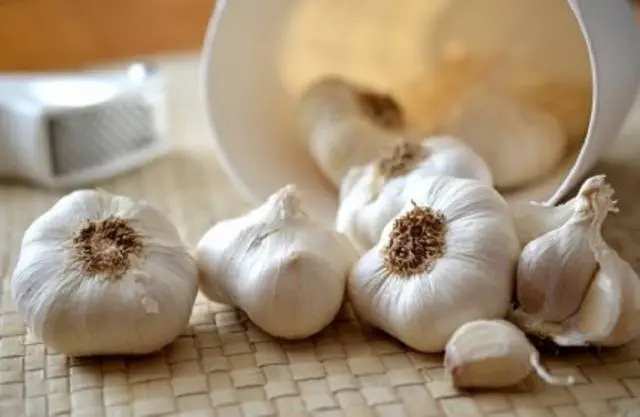
It is not difficult to grow a vegetable, but if you miss the harvest time, it will be problematic to keep it until spring. You need to dig garlic on time, otherwise the heads will disintegrate and be poorly stored.
There are two types of garlic – spring and winter. He has different planting dates, so he will also have to harvest at different times. Culture itself tells you when to remove garlic from the garden. Carefully observe the plant, and you will accurately determine the time of harvesting the garlic.
The main signs of ripeness
Harvesting unripe or overripe garlic is unacceptable. In this case, all the efforts expended on growing a vegetable will be lost. If you dig earlier, the cloves will be soft. Although some summer residents use digging ahead of time so that the heads ripen during drying.
An overripe vegetable can re-sprout and sprout. The integumentary scales will crack, and the teeth will remain without husks. Naturally, such heads will be poorly stored. Therefore, the garlic must be harvested on time.
By what signs do gardeners determine the ripeness of the heads? The main indicators that it is time to harvest garlic are:
- yellowing of the leaves, especially the lower ones;
- the moment of drying of the outer films on the inflorescences;
- acquisition by films of varietal coloring;
- straightening the arrows of the arrowing variety;
- stem lodging;
- separation of teeth without effort;
- cracking of seed pods.
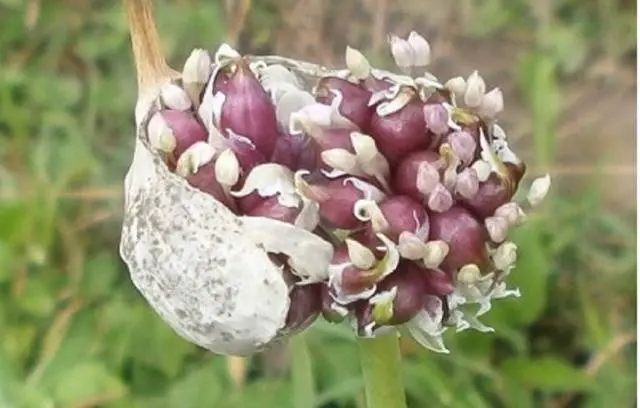
These signs show that the technical maturity of the garlic has come, but the formation of the bulbs has not yet occurred. The process will finally end after harvest.
How to determine the date when you need to remove the garlic from the garden? There is no single number for all regions. Several factors have to be taken into account. The main ones are climatic conditions. For the middle lane, it serves as a guide on July 12 – the day of Saints Peter and Paul. In the northern regions, the time for harvesting garlic comes a couple of weeks later. What date to remove the heads in other regions is calculated according to the recommendations of the lunar calendar and the weather forecast.
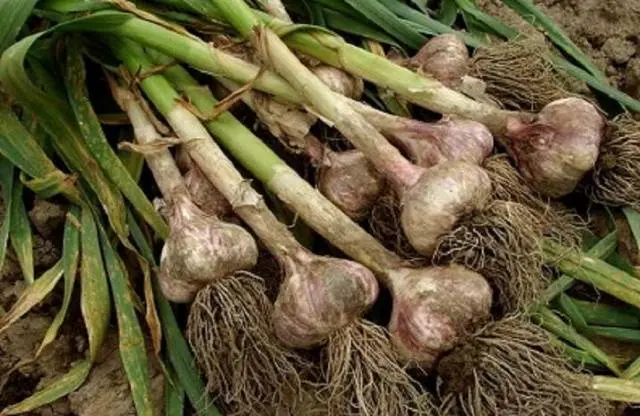
It is necessary to shift the harvesting time of the heads, focusing on the external signs of the plant. Frequent rains will cause garlic to ripen earlier than usual, hot and dry days will push this process a couple of weeks later. Another important factor is the fulfillment of agrotechnical requirements, namely the number of top dressings. Therefore, the date when to dig up garlic must be determined every year.
Spring garlic gardeners are advised to start digging in August, given the time of planting and the growing season of the variety. The spring species is stored better than the winter one, so just keep the time when its heads must be removed for storage.
Ways to improve the quality of garlic heads
To properly harvest a vegetable, you need to start with proper preparation. Before harvesting garlic, summer residents carry out pre-harvest activities that significantly improve the quality of the heads. Begin preparation at the moment when the arrows are straightened. This indicator signals that the bulbs are beginning to pour. It is necessary to increase the flow of nutrients to the garlic heads. This can be done by tying the leaves in a knot.

But it should be remembered that such a technique will increase the ripening period of garlic by 2 weeks.
The next nuance is that the soil is raked from the bulbs to increase air access to the roots. This is done at the time when the inflorescences are straightened. Reception protects the bulbs from wetting and accelerates their formation by 3-4 days.
Harvesting garlic according to the rules
Harvesting garlic has its own subtleties. How to harvest in order to preserve all the bulbs in a quality manner? Gardeners adhere to certain rules.
Choose a sunny and warm day. The main thing is that there was no rain the day before.
You can dig up the bulbs with a fork or a shovel. This must be done very carefully, trying not to damage the heads with a sharp tool.
Cutting the tops and roots is strictly prohibited.
After digging up the plant, lightly shake it off the ground and set it aside to dry. The place should be chosen dry, but without direct sunlight. Experienced summer residents prepare a canopy in advance.
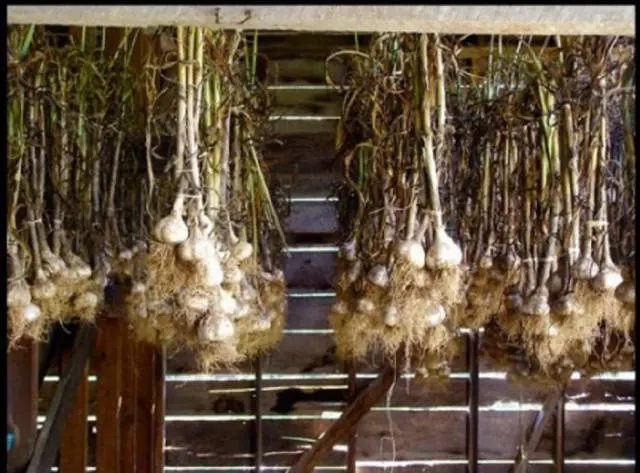
Dry the vegetable for at least 14 days. Then it must be cleared of the ground and cut off the leaves. 1-2 layers of integumentary scales are removed from the bulbs, no more. Otherwise, they will not store well.
The heads are much better stored if the roots are cut with a sharp knife at a distance of 2-3 mm from the bottom, and the bottom itself is singeed. Can be waxed. Tops are trimmed depending on the storage method. For a bunch, it is enough to leave 10-20 cm of the stem, and for a braid you will need at least 35 cm. Separately, flower stalks are tied and stored.
Storing bulbs before planting
There are general requirements for high-quality storage of garlic:
- the bulbs must be perfectly dry;
- the room should be dark;
- the winter species needs cold (+3°C), the spring species also withstands heat (+18°C).
Categorically not suitable for storing places with high humidity, drafts and air temperatures above 22 ° C. Therefore, the refrigerator is not suitable for storing any kind of garlic due to the high humidity.
Methods for storing spicy vegetables are known to many summer residents.
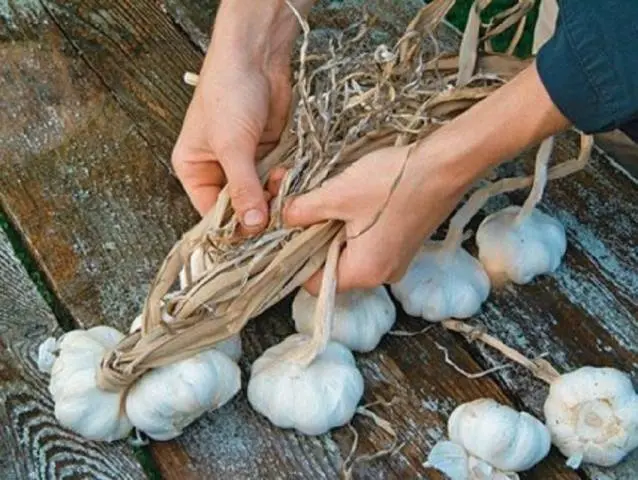
The option is chosen depending on the possible conditions. In the presence of a dry basement or attic, garlic is well preserved in:
- I was mowing. Advantage – does not require a lot of space, it is easy to find and remove a damaged head.
- Baskets. Good breathability and very compact. The bulbs are folded in 3 layers, at high humidity they are sprinkled with onion peel.
- I snapped. Suitable for storing small quantities of garlic (up to 20 pieces) in a barn or attic.
- Networks. Hang on the wall in the basement, in the attic, in the barn.
In apartments, only the option with glass jars is possible, and in a private house, linen bags, boxes, jars and boxes are used.
Summer residents believe that it is easier to harvest garlic than to preserve it in a quality manner. During winter storage, problems may arise:
- The heads are moldy and rot. This is due to high humidity. The heads must be sorted, removing the damaged ones. The rest are placed for a week to dry in a warm place and continue to be stored in a dry place. You can sprinkle the garlic with salt.
- Teeth dry up. The winter variety is prone to natural drying out at the end of the storage period. To push back this period, the heads are wrapped in cling film. With early drying, the bulbs are moved for several days in the refrigerator, then wrapped in a film.
- Color changes. Occurs when the stem nematode is damaged. A bulkhead and separation of healthy garlic from the infected is necessary. Burn the patient, the rest must be pickled with an insecticide, dried and continued storage in optimal conditions.
- The teeth are growing. In this case, they are cleaned and filled with oil (vegetable). The storage temperature is maintained either not higher than +2°С, or +20°С and higher.
- Pest damage. With a small degree, the garlic is heated in the oven at a temperature of 100 ° C. Then sorted out, the affected are burned.
You can store garlic in different ways at the same time. The most suitable of them should be chosen in order to save the crop before planting.
In the best position will always be the one who collects garlic with high quality and on time.









